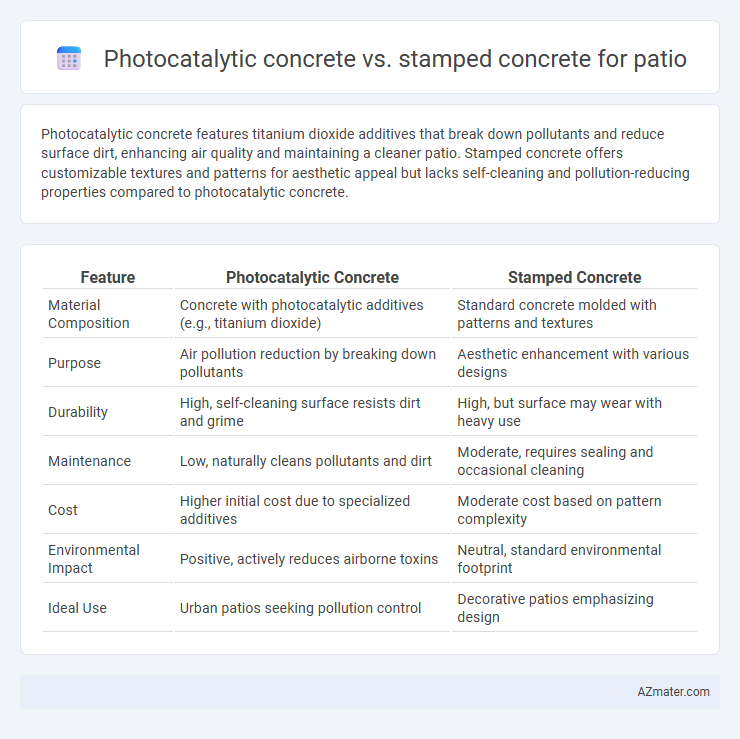Photocatalytic concrete features titanium dioxide additives that break down pollutants and reduce surface dirt, enhancing air quality and maintaining a cleaner patio. Stamped concrete offers customizable textures and patterns for aesthetic appeal but lacks self-cleaning and pollution-reducing properties compared to photocatalytic concrete.
Table of Comparison
| Feature | Photocatalytic Concrete | Stamped Concrete |
|---|---|---|
| Material Composition | Concrete with photocatalytic additives (e.g., titanium dioxide) | Standard concrete molded with patterns and textures |
| Purpose | Air pollution reduction by breaking down pollutants | Aesthetic enhancement with various designs |
| Durability | High, self-cleaning surface resists dirt and grime | High, but surface may wear with heavy use |
| Maintenance | Low, naturally cleans pollutants and dirt | Moderate, requires sealing and occasional cleaning |
| Cost | Higher initial cost due to specialized additives | Moderate cost based on pattern complexity |
| Environmental Impact | Positive, actively reduces airborne toxins | Neutral, standard environmental footprint |
| Ideal Use | Urban patios seeking pollution control | Decorative patios emphasizing design |
Introduction to Photocatalytic and Stamped Concrete
Photocatalytic concrete incorporates titanium dioxide to break down pollutants and reduce surface dirt through a chemical reaction activated by sunlight, making it ideal for eco-friendly patios with low maintenance requirements. Stamped concrete mimics the appearance of natural stone, brick, or wood by imprinting patterns onto freshly poured concrete, offering a customizable and visually appealing patio surface. Both materials provide durability and aesthetic enhancement, with photocatalytic concrete emphasizing environmental benefits and stamped concrete focusing on design versatility.
How Photocatalytic Concrete Works
Photocatalytic concrete contains titanium dioxide (TiO2) nanoparticles that activate under UV light to break down pollutants like nitrogen oxides and volatile organic compounds, promoting cleaner air around patios. This chemical reaction transforms harmful substances into less toxic compounds such as nitrates, which are washed away by rain, effectively reducing environmental pollution. Unlike stamped concrete, which mainly offers decorative appeal, photocatalytic concrete combines durable patio surfaces with air-purifying benefits, making it an eco-friendly construction choice.
Features of Stamped Concrete for Patios
Stamped concrete for patios offers a durable, cost-effective solution that mimics natural materials like stone, brick, or wood, providing aesthetic versatility without the high maintenance of those materials. Its textured surface enhances slip resistance and can be customized with various patterns, colors, and finishes to complement outdoor design themes. Compared to photocatalytic concrete, stamped concrete lacks self-cleaning or pollution-reducing properties but excels in decorative appeal and structural strength for patio applications.
Aesthetic Differences: Photocatalytic vs Stamped Concrete
Photocatalytic concrete features a smooth, self-cleaning surface that maintains its bright, clean appearance by breaking down pollutants, making it ideal for minimalist and modern patio designs. Stamped concrete offers intricate textures and patterns that can mimic natural stone, brick, or wood, providing a highly customizable aesthetic tailored to traditional or rustic outdoor spaces. While photocatalytic concrete emphasizes long-term cleanliness and subtle elegance, stamped concrete prioritizes detailed visual variety and tactile appeal.
Durability and Maintenance Comparison
Photocatalytic concrete offers superior durability due to its ability to self-clean and resist surface pollutants, reducing wear and extending lifespan compared to stamped concrete. The photocatalytic process breaks down organic materials and grime, significantly decreasing maintenance frequency and costs, whereas stamped concrete requires regular sealing and repair to prevent cracking and fading. Stamped concrete, while aesthetically versatile, is more susceptible to weathering and surface damage, making it less ideal for long-term low-maintenance patios.
Environmental Impact and Sustainability
Photocatalytic concrete utilizes titanium dioxide to break down pollutants and improve air quality, making it an eco-friendly choice for patios focused on reducing urban pollution. This material actively enhances environmental sustainability by reducing airborne contaminants and requiring less frequent cleaning, contributing to lower maintenance emissions. In contrast, stamped concrete primarily offers aesthetic appeal with limited environmental benefits and often involves more extensive production processes that increase carbon footprints.
Cost Analysis: Photocatalytic vs Stamped Concrete
Photocatalytic concrete typically incurs higher initial costs due to advanced materials and technology integration aimed at air purification and pollution reduction, whereas stamped concrete offers a more budget-friendly upfront investment through conventional materials and customizable patterns. Maintenance expenses for photocatalytic concrete remain relatively low as its surface resists staining and requires minimal cleaning, contrasting with stamped concrete which demands periodic sealing and repair to preserve its appearance and prevent cracking. Long-term cost efficiency favors photocatalytic concrete in urban environments given its durability and environmental benefits, while stamped concrete appeals to homeowners prioritizing aesthetic versatility within a tighter budget.
Slip Resistance and Safety Considerations
Photocatalytic concrete offers enhanced slip resistance due to its photocatalytic surface that breaks down organic matter, reducing algae and mold buildup, making patios safer in wet conditions. Stamped concrete, while visually appealing with textured patterns, can become slippery when wet if not sealed properly or treated with anti-slip additives. For optimal safety, photocatalytic concrete is preferable in areas prone to moisture as it naturally maintains a cleaner, less slippery surface.
Installation Process and Timeframe
Photocatalytic concrete requires specialized application techniques involving the integration of titanium dioxide for air-purifying properties, often needing skilled professionals and careful curing times that can extend installation to several days. Stamped concrete installation involves pouring, coloring, and imprinting patterns shortly after pouring, allowing for faster completion typically within one to two days depending on patio size and weather conditions. The curing process for photocatalytic concrete is critical to activate its pollution-reducing functionality, whereas stamped concrete emphasizes aesthetic detail with quicker surface finishing.
Which Concrete is Best for Your Patio?
Photocatalytic concrete offers self-cleaning and air-purifying benefits through titanium dioxide, reducing pollution and maintenance needs, making it ideal for eco-conscious patios. Stamped concrete provides customizable aesthetics with various patterns and textures, enhancing visual appeal and mimicking natural materials like stone or brick. Choosing the best concrete for your patio depends on prioritizing environmental sustainability and low upkeep versus decorative design and personalization.

Infographic: Photocatalytic concrete vs Stamped concrete for Patio
 azmater.com
azmater.com